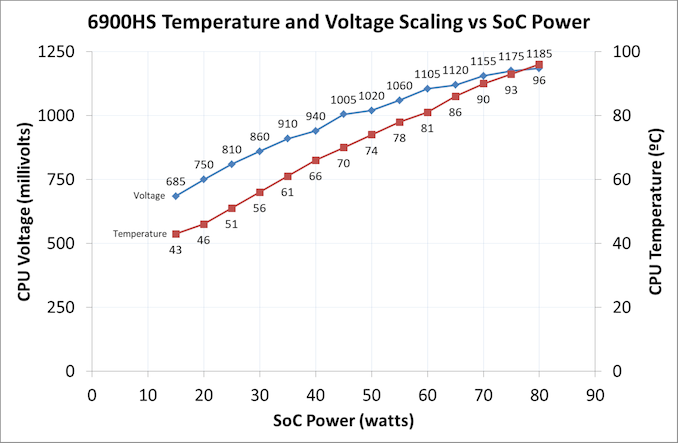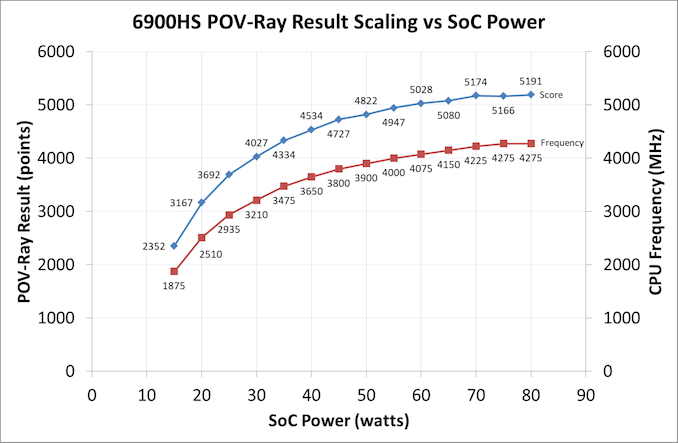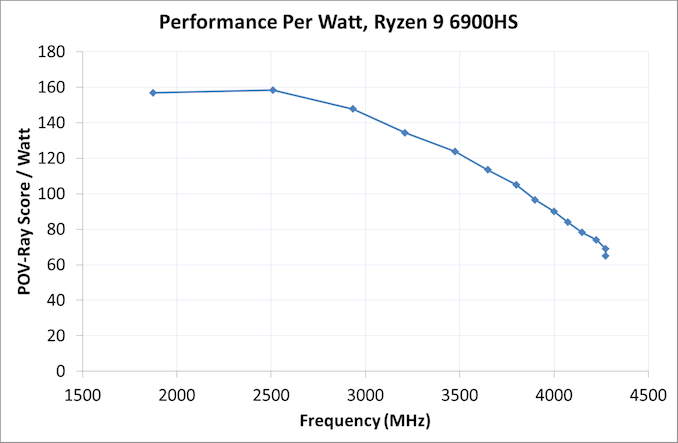AMD's Ryzen 9 6900HS Rembrandt Benchmarked: Zen3+ Power and Performance Scaling
by Dr. Ian Cutress on March 1, 2022 9:30 AM ESTPerformance Per Watt
With the ASUS Zephyrus G14, it comes with some fancy ASUS software called the Armo(u)ry Crate. Inside is the usual array of options for a modern laptop when it comes to performance profiles, fans, special RGB effects and lighting, information about voltages, frequencies, fan speeds, fan profiles, and all that jazz. However inside the software there is also an interface that allows the user to cap how much APU/SoC power can be put through the processor or the whole platform.
With this option, we took advantage of the fact that the after we select a given SoC wattage, the system will automatically migrate to the required voltage and frequency under load while only ever going up to the power limits - or as much as the system would be allowed to. Using this tool, we ran a spectrum of performance data against power options to see how the POV-Ray benchmark would scale, as it is one of the benchmarks that drives core use very high and very hard.
In this first graph, we monitor how the CPU voltage increases by raising the power, as well as the at-load temperature of the processor. The voltage increments start off around the 60-65 mW per 5W of SoC power, eventually becoming 15-25 W due to the way that voltage and power scales. The temperature was a very constant rise, showing 96ºC with the full 80 W selected.
Now if we transition this to the benchmark results, as we plot this with the all-core frequency as well:
These two lines follow a similar pattern, as the score doesn't increase if the frequency doesn't increase. The biggest jumps are in the 15-35W mark, which is where most modern processors are the most efficient. However as the power is added in, the processor moves away from that ideal efficiency point, and going from 50 W to 80 W is a 60% power increase for only +375 MHz and only +7.7% increased score in the benchmark.
We can pivot this data into something a bit more familiar:
Here we can see the voltage required for all-core frequencies and how the voltage scales up. With all this data, we can actually do a performance per watt graph for Rembrandt:
In this graph we're plotting Score per watt against Frequency, and it showcases that beyond 2.5 GHz, the Rembrandt CPU design becomes less efficient. Most modern processors end up being most efficient around this frequency, so it isn't perhaps all that surprising.
Now all of this is also subject to binning - not only are chips binned by the designation (6900HS vs 6800H for example), but also within an individual SKU, there will be better bins than others. We see this in some mobile processors that can have 10+ bins with different voltage/frequency characteristics, but all still called the same, because they perform at a shared guaranteed minimum. With smartphones, this testing is a lot easier, as that voltage/frequency table is often part of the hardware mechanism. But for notebooks and desktops, we're often at the mercy of the motherboard manufacturer or OEM, who can use their own settings, overriding anything that Intel or AMD suggest. Hopefully in the future we will get more control and be able to determine what is manufacturer based and what is motherboard based.















92 Comments
View All Comments
yankeeDDL - Tuesday, March 1, 2022 - link
Great article, as usual.It seems clear that Intel's AL still has the performance advantage, however, in the Conclusion page, the performance comparison is reference to the nominal consumption (35W, 45W, 65W), while we know that Intel's part can reach twice as much power, in practice, making an apples-to-apples comparison quite difficult, especially in light of Intel's better scaling with more Power.
Is there a way to check the exact performance per core under the same exact consumption (or scaled)?
I am especially interested as a user of the 1165G, which is an absolute battery eater (and/or heater): it seems that AL is a huge improvement, but if it also draws 100W (instead of 45W) to beat Ryzen by a 10%, then it's not worth it. In my opinion.
Spunjji - Tuesday, March 1, 2022 - link
Yes, the overall picture that has built up is of Intel's Alder Lake winning out at higher power levels (40W+) while AMD coming out ahead below that.This is good, because it means that we have great options for people who want the best possible performance in a mobile form-factor and for people who want a more even balance of performance and power usage. It's a nicer situation to be in than when Intel complete owned the mobile segment, followed by the years of stagnation at 14nm.
yankeeDDL - Tuesday, March 1, 2022 - link
Agree on all points.Intel's Tiger Lake is an absolute disaster, and it is actually surprising that Intel only managed to lose 50% market share with such a lousy product compared to Ryzen.
And equally surprising is the insane jump in performance and perf/watt achieved with AL. Definitely good for the consumers.
mode_13h - Tuesday, March 1, 2022 - link
> Intel's Tiger Lake is an absolute disasterThat seems like an overstatement. It just didn't improve enough against Ryzen, particularly in light of the 5000-series' gains. However, especially in light of Ice Lake's disappointments, Tiger Lake didn't seem so bad.
Alistair - Tuesday, March 1, 2022 - link
Tiger Lake was a stroke of luck for Intel, their worst product ever during a massive silicon shortage. They spent the year selling quad cores because AMD was selling everything they could make, not because Tiger Lake was any good.bigboxes - Wednesday, March 2, 2022 - link
For sure. I went with AMD for the first time since 2006 this last year.Samus - Thursday, March 3, 2022 - link
The irony here is AMD mobile CPU's are widespread in lots of desktops and AIO's, even high end units. You would rarely, if ever, see Intel U-series parts in desktops\AIO's outside of USFF's or low-end AIO's with Celeron\Pentiums.This is happening partially because AMD doesn't have a wide product stack like Intel. And they don't need too. The AMD U-series parts are absolute performance monsters and have been for the last 3 generations.
abufrejoval - Friday, March 4, 2022 - link
I own both, a Ryzen 5800U in a notebook and an i7-1165G7 as a NUC.They are really quite comparable, both in iGPU performance, in scalar CPU power and even in multi-threaded CPU power.
At 15 Watts the 8 Ryzen cores operate below the CMOS knee, which means they have to clock so low they can't really gain much against 4 Tiger Lake cores clocking above it. Synthetic benchmarks may prove a lead that's next to impossible to realize or really relevant in day-to-day work. For the heavy lifting, I use a 5950X, which isn't that much faster on scalar loads, but runs almost as many rings around the 5800U as the i7-1165G7: the extra Watts make more of a difference than the cores alone.
My impression is that the Ryzen needs the higher power envelope, 35 or even 65 Watts, and of course a matching workload to put those extra cores to work. AMD's primary aim for their APUs was to cover as many use cases as possible from a single part and they do amazingly well. If they could afford to do a native 4 core variant as well, I'm pretty sure that would outsell the 8 core.
In fact the SteamDeck SoC would probably make a better notebook part for many (not everyone).
And there is nothing wrong with Tiger Lake, except that perhaps today there are better SoCs around: it was and remains a welcome improvement over the previous generations from Intel.
Buy it used and/or cheaper than these AL parts and you should have little to complain about... unless complaining is what you really enjoy.
mode_13h - Tuesday, March 1, 2022 - link
> Great article, as usual.I thought so, as well, which was a relief. Then, I noticed the by-line:
"by Dr. Ian Cutress"
lemurbutton - Tuesday, March 1, 2022 - link
People shouldn't care that much about AMD and Intel on laptops right now. M1 series completely destroys both. AMD and Intel are 3-4 years behind.